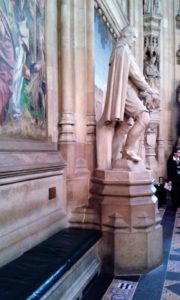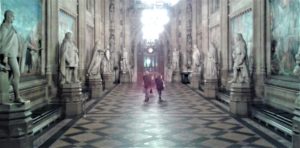Blog 3: Working in Parliament
The three months during which I was interning at POST were a particularly chaotic time for UK politics. When I arrived in February 2017, people were still reeling from the results of the BREXIT vote, and that was reflected in the type of work that was being carried out by many of the interns at POST. Many of their POSTnotes focussed on how certain areas of science (particularly medicine) might be affected by leaving the EU, and what opportunities this may provide. I found that Parliament is a pretty hectic place to work, from the snap general election which took everyone by surprise, to a cyber-attack which hit the IT systems of the entire Parliamentary estate!
When I arrived to start my internship at POST I was taken on a tour of Westminster Palace; the building where parliament is based. I was given an all-access pass to the Parliamentary Estate, allowing me to wander freely around many of the parts of the estate that are not open to the general public.
Westminster Palace is a very impressive building, with paintings, tapestries and statues around every corner! It is also very confusing to get around! The main visitor entrance takes you into Westminster Hall (main picture), which is the oldest building in the Parliamentary estate. It is a grand Hall, with a high timber roof that has been there for over 900 years, and suffered through various fires and restorations during this time! The stairs then take you up into the grand Central Lobby where BBC news often reports live on TV, and surprisingly there is also a Post Office! If you turn left through here, you will enter the House of Commons chamber, and right will take you to the House of Lords Chamber. The carpets are coloured depending on which of the Houses you are in, which helps to make it less confusing! If you know where to look, you can use the staircases hidden behind statues (think Harry Potter!) to get to the Parliamentary meeting rooms upstairs, where smaller meetings are held, or down to the cafes for lunch, such as the Terrace overlooking the Thames, and the Barry Room Brasserie (which required a smart dress code and being accompanied by a more senior member of staff!).

The statue of Viscount Falkland with a broken spur where Marjory Hume, a female suffragette, chained herself to the statue as she protested for women’s right to vote and had to be cut free.
During my time in the Palace, I brushed shoulders with well-known MPS such as Nick Clegg and Tim Farron, and I even saw David Blunkett and his Guide Dog Cosby in Portcullis House, which is where many MPs go to have coffee meetings or lunch. I also was able to watch the speakers procession, and attend Prime Ministers Questions. As a non-Londoner, I had my first experience of commuting on the tube, and got to use the “secret” underground tunnel from Westminster tube station into Westminster Palace!
It was a really interesting experience to learn about the historical importance of this building, and to see how politics is still carried out inside it today.
Blog 1 Science and Parliament: http://www.bangscience.org/2017/07/internship-at-post-blog-1/
Blog 2 Engaging with Parliament: http://www.bangscience.org/2017/08/internship-at-post-blog-2/
![Internship at POST: Blog 3 Blog 3: Working in Parliament The three months during which I was interning at POST were a particularly chaotic time for UK politics. When I […]](/wp-content/uploads/2017/09/Westminster_Hall_in_the_Palace_of_Westminster-620x300.jpg)
